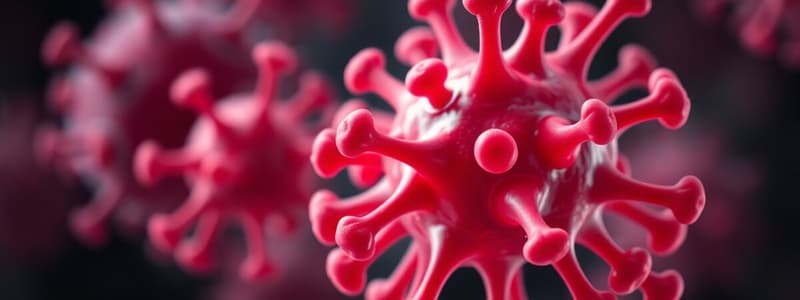Podcast
Questions and Answers
What is a symptom of muscarinic effects caused by organophosphate intoxication?
What is a symptom of muscarinic effects caused by organophosphate intoxication?
- Hypertension
- Seizures
- Muscular twitching
- Bradycardia (correct)
Which antidote primarily functions as a muscarinic antagonist?
Which antidote primarily functions as a muscarinic antagonist?
- Seizure medication
- Atropine (correct)
- PAM
- Dichlorovinyl dimethyl phosphate
Which symptoms are associated with the CNS effects of organophosphate intoxication?
Which symptoms are associated with the CNS effects of organophosphate intoxication?
- Hyperactivity and muscle rigidity
- Increased lacrimation and hypotension
- Seizures and anxiety (correct)
- Diarrhea and facial twitching
What is the role of PAM in the detoxication of organophosphates?
What is the role of PAM in the detoxication of organophosphates?
What is the main effect of organophosphate intoxication on the respiratory system?
What is the main effect of organophosphate intoxication on the respiratory system?
Which of these symptoms could occur due to nicotinic effects in organophosphate intoxication?
Which of these symptoms could occur due to nicotinic effects in organophosphate intoxication?
During the experiment, what is the purpose of observing the rabbits’ indexes before and after administration of DDV?
During the experiment, what is the purpose of observing the rabbits’ indexes before and after administration of DDV?
What change is expected after administering 1 ml/kg of atropine to a rabbit suffering from organophosphate intoxication?
What change is expected after administering 1 ml/kg of atropine to a rabbit suffering from organophosphate intoxication?
Flashcards
How do Organophosphates cause intoxication?
How do Organophosphates cause intoxication?
Organophosphate poisoning occurs when these chemicals block the enzyme cholinesterase, leading to a buildup of acetylcholine, a neurotransmitter, in the body. This excess acetylcholine causes various symptoms related to nervous system malfunction.
What is the mechanism of action of Atropine?
What is the mechanism of action of Atropine?
Atropine, a muscarinic antagonist, counteracts the excessive acetylcholine by blocking its receptors. It primarily relieves symptoms like miosis, hypersalivation, and cardiovascular issues.
What is the mechanism of action of PAM?
What is the mechanism of action of PAM?
Pralidoxime (PAM) reactivates cholinesterase, the enzyme that breaks down acetylcholine. By doing so, it helps restore the normal breakdown of acetylcholine and reduces the overall concentration of this neurotransmitter in the body.
What is miosis?
What is miosis?
Signup and view all the flashcards
What is hypersalivation?
What is hypersalivation?
Signup and view all the flashcards
How does organophosphate poisoning affect respiration?
How does organophosphate poisoning affect respiration?
Signup and view all the flashcards
What are muscarinic symptoms in organophosphate poisoning?
What are muscarinic symptoms in organophosphate poisoning?
Signup and view all the flashcards
What are nicotinic symptoms in organophosphate poisoning?
What are nicotinic symptoms in organophosphate poisoning?
Signup and view all the flashcards
Study Notes
Organophosphate Intoxication and Detoxication
- Organophosphates cause intoxication by inhibiting acetylcholinesterase (AChE)
- AChE breaks down acetylcholine (ACh)
- Inhibition leads to acetylcholine accumulation
- Accumulation overstimulates muscarinic and nicotinic receptors
- This results in a range of symptoms, both muscarinic and nicotinic
Experimental Purposes
- Determine the symptoms of organophosphate intoxication
- Evaluate the effect of atropine and pralidoxime methiodide (PAM) on detoxication
- Compare the effects of atropine and PAM
Experimental Principle
- Investigate the mechanism and symptoms of organophosphate intoxication
- Examine the mechanism of action of antidotes
Mechanism of Organophosphate Intoxication
- Acetylcholine is broken down by acetylcholinesterase (AChE) into choline and acetic acid
- Organophosphates inhibit AChE
- Acetylcholine accumulates
- Accumulation overstimulates muscarinic and nicotinic receptors, causing intoxication
Muscarinic Effects
- Eyes: blurred vision, miosis
- Glands: increased lacrimation
- Cardiovascular: bradycardia, hypotension
- Respiratory: severe respiratory distress
- Gastrointestinal: nausea, vomiting, abdominal pain, diarrhea, fecal incontinence
- Genitourinary: urine incontinence
Nicotinic Symptoms
- Neurological: hypertension, decreased muscular tension, muscular twitching
CNS Effects
- Anxiety
- Seizures
- Coma
Antidotes and Mechanism
- Atropine: Muscarinic antagonist; relieves muscarinic symptoms (miosis, hypersalivation, fecal/urine incontinence), inhibits cardiovascular system
- PAM (Pralidoxime methoiodide): Cholinesterase reactivator; reverses organophosphate-induced AChE inhibition; regenerates AChE activity
Experimental Material
- Animal: Rabbit (2-3 kg)
- Instruments: Rabbit cage, syringes
- Drugs:
- 0.08% dichlorovinyl dimethyl phosphate (DDV)
- 0.1% atropine
- 2.5% PAM
Experimental Procedure
- Weigh the rabbit and observe normal indexes (respiration, pupils, salivation, feces, urine, muscle tension, muscle twitching)
- Administer 0.08% DDV (1 ml/kg, intramuscular) and observe changes in indexes
- When intoxication symptoms (e.g., seizures) appear, administer atropine (1 ml/kg, intravenous). Observe changes.
- After M-symptoms disappear, administer PAM (2 ml/kg, intravenous). Observe changes.
Results and Analysis
- Results table for different experimental indexes (pupils, saliva, feces/urine, muscular tension, muscular twitching) before and after treatment
Questions
- Analyze the mechanism of organophosphate intoxication
- Analyze the detoxication mechanism of atropine and PAM
Studying That Suits You
Use AI to generate personalized quizzes and flashcards to suit your learning preferences.




